FK Kauno Žalgiris are a relatively new club in Lithuanian football, having been created in 2004, yet they have rapidly thrown their name in the hat for the strongest side in the country. The Žaliai Balti have achieved top-four finishes in the previous five seasons, allowing them to compete in European qualification matches. However, they’ve never made it through to proper European competition.
From set plays, the Lithuanian side has stood out due to the frequency of goals they’ve scored on the way to a fourth-place finish in the A Lyga in the 2023 season. 17 set play goals in 36 league games, totaling 28% of their entire goal tally throughout the season, which shows how strong they have been in this aspect of the game.
In this tactical analysis, we will look into the tactics behind FK Kauno Žalgiris’s offensive corners, with an in-depth analysis of why their preferred corner routine, in particular, has been so efficient. This set-piece analysis will examine why this routine has helped them score so many goals, with a focus on the importance of the use of decoy runs and how the timing of runs plays a big part in determining the likelihood of success.
Creating space in the six-yard box
FK Kauno Žalgiris’s intent is to attack the space inside the six-yard box in the area nearby the near post. There are numerous ways in which it is possible to create space, with the Lithuanian side opting to use decoy runs to achieve success. Decoy runs are made from players who start within the goalposts. From there, they move towards the ball, as is evident in the example below.
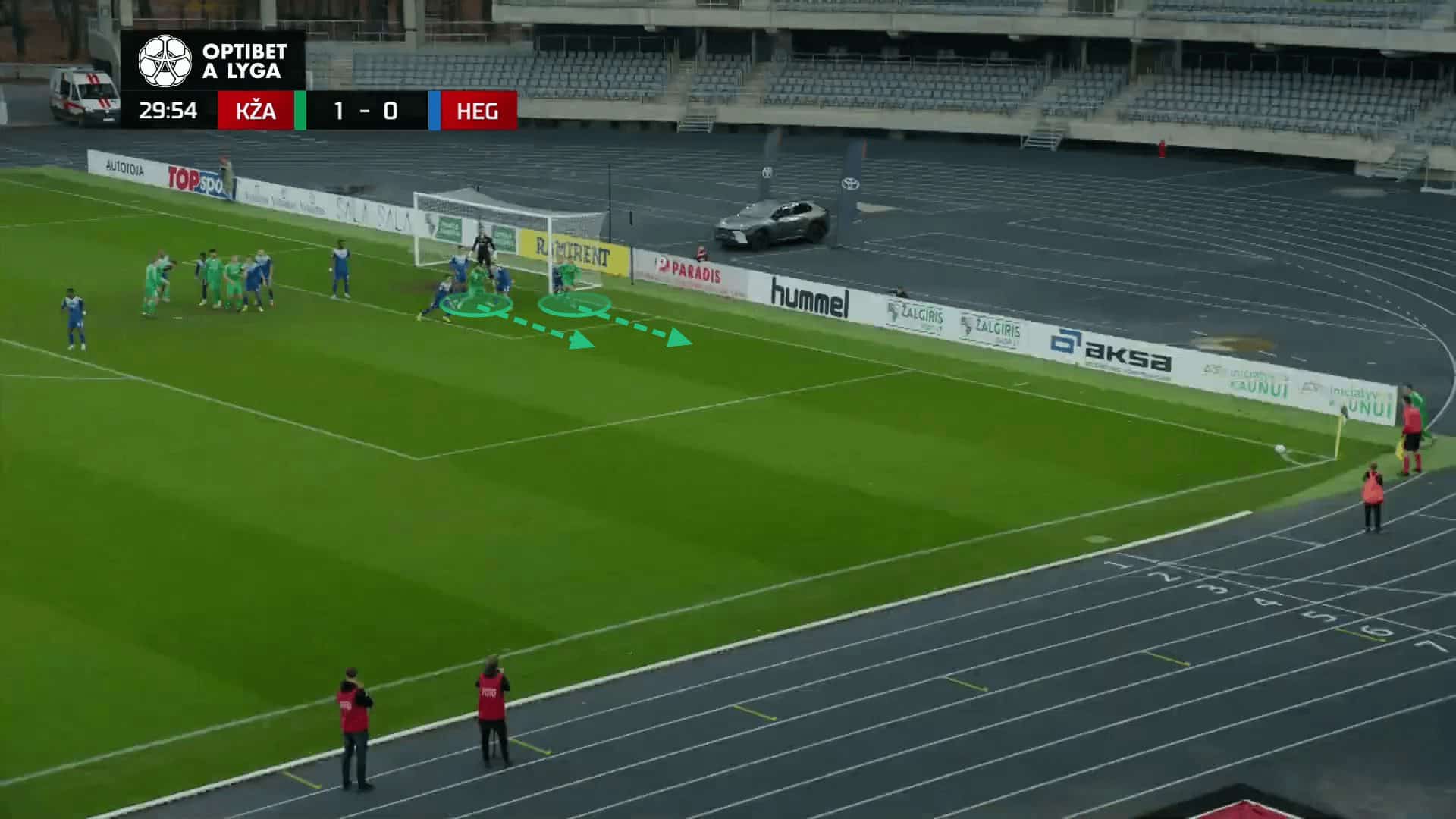
These runs have the initial benefit of allowing players to arrive in space before a defender can react to the movements. However, the primary factor behind the decoy run is to attract zonal defenders away from the areas inside the six-yard box.
We can see in the following screenshot the zonal defender responsible for the area highlighted is lured away by the decoy run made in front of him. It is vital to have every player in and around the six-yard box closely marked due to the catastrophic consequences that can occur following an unopposed header from such a close distance.
When the run is made past the zonal defender’s shoulder from his blind spot, he is unaware if that player is being marked, and in the split-second moment, a decision must be made. Quite often, this results in that zonal defender following the attacker, which leaves a huge gap inside the six-yard box.
This can be countered by quick and clear communication, with the man marker letting the zonal defender know to hold his position if he has been able to track the run tightly enough.
There is also a possibility where the man marker could potentially rotate and swap roles with the zonal defender, plugging the hole the zonal defender leaves. Usually, the use of two decoy runs is enough to lure zonal defenders away from their positions.
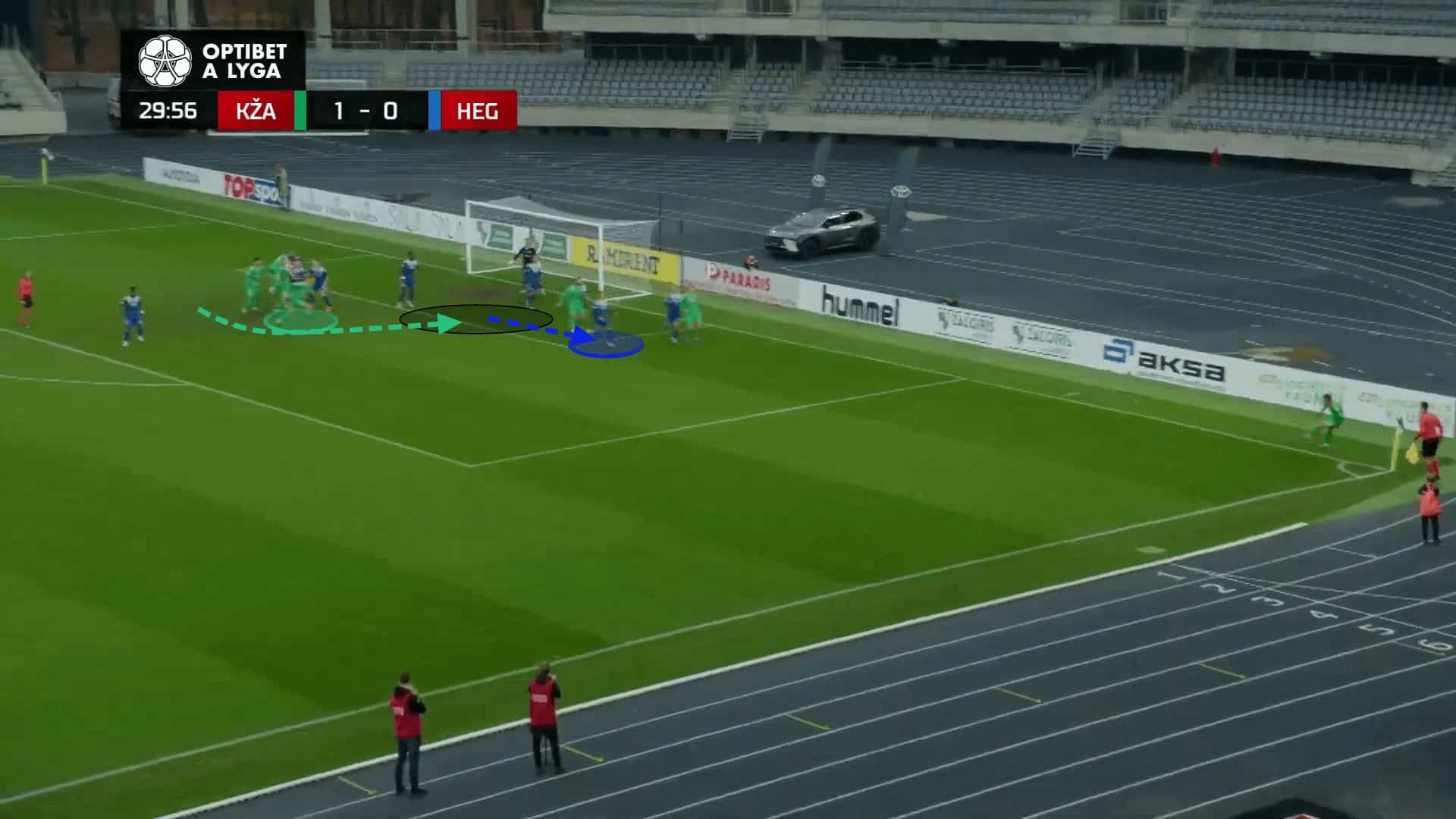
As seen in the example above, the next part of the plan is simultaneously being carried out with an attacker from deep attacking the space that the defender has just vacated. The second phase of the corner involves an additional attacking unit of four players who start around the penalty spot, using a ‘train’ method.
The four attackers all queue up to the goal, remaining touch tight, which prevents defenders from marking their players tightly right from the start. When the corner is about to be swung in, the players make alternating runs towards the front and back posts, where the crossover movement from each player causes that little extra bit of chaos.
If the markers start deep, they are at risk of allowing an attacker to arrive in space earlier than them, due to the run-up and momentum of the attackers. However, if defenders choose to remain close but by either side of the attacker and not goal-side, they are vulnerable to being on the wrong side of their player and giving them a free path to the ball if, for example, a defender in the image below is by an attacker’s right shoulder, when they make a movement to their left side, towards the near post.
With the attackers making opposite movements, defenders have a lot of traffic to get through to mark the players they are supposed to closely. If they are to avoid all the traffic, they must decelerate or change the path of their run, which gives the attackers the extra separation to attack the ball unopposed.
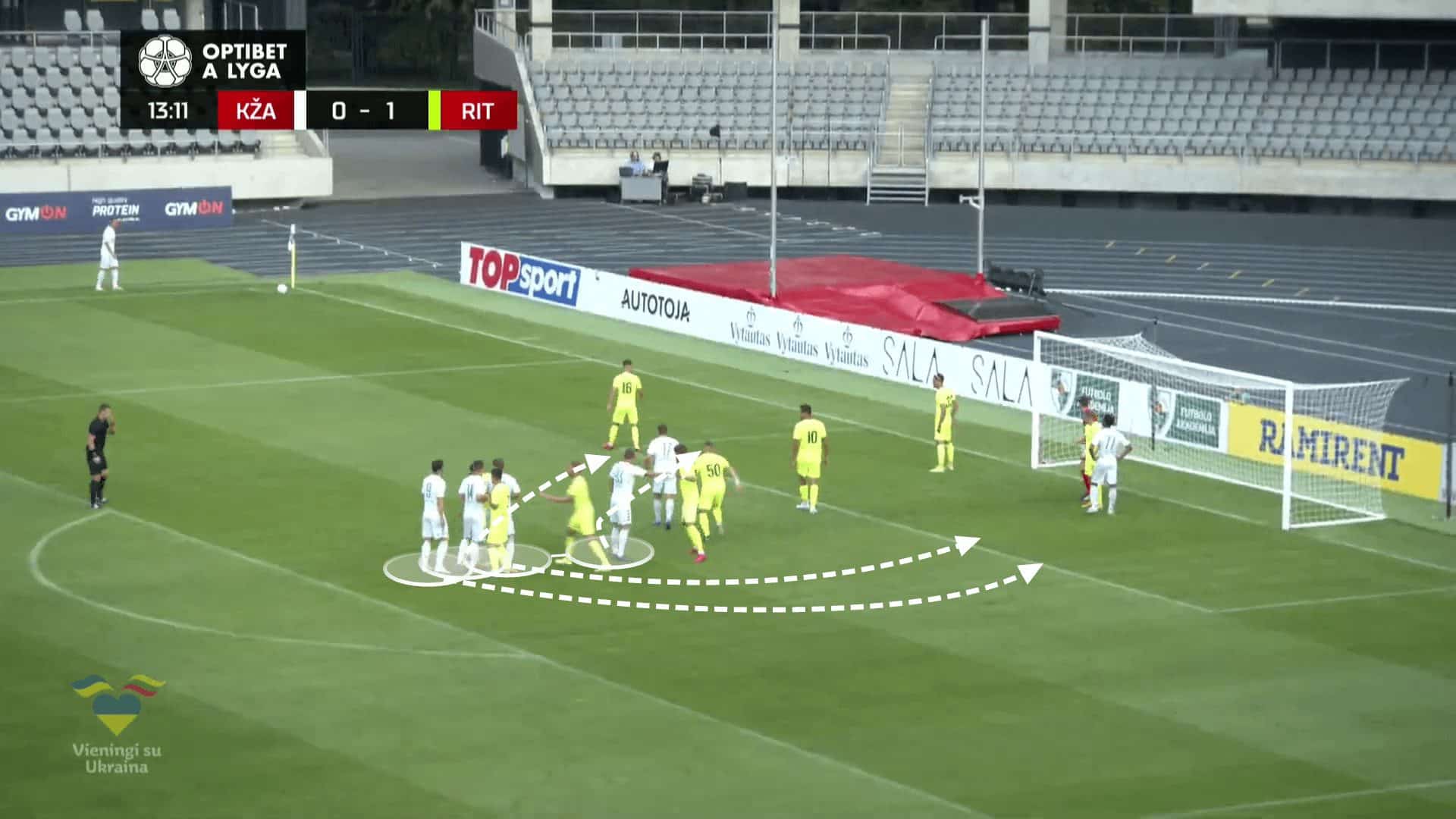
The timing of the runs is essential to the success rate of this routine. The decoy run needs to be made early enough to attract a zonal defender away from their position but not too early so that his original man-marker can recover his position before the ball is delivered.
In general, the aim for one of the decoy runners is to move across the zonal defender into his view as the corner is taken, where the defender then follows the run, thinking the ball is meant for that run. One of the issues which Kauno Žalgiris have had, limiting the overall number of set-piece goals they had managed to score last season, was with the timing of the decoy runs in relation to the position of the zonal defenders.
When runs were made too early, zonal defenders had no panic as the ball wasn’t moving towards the box, so there was time for the original man marker to recover his position.
When corners were taken too early, and the runs were late, like in the example below, the ball was in flight before a run was made across the front of the defender, and that zonal defender had no threatening runs to track. By the time the run was made across the front of him, he would have had enough time to react to the flight of the cross and realise where the ball was intended to arrive, which allowed him to ignore the decoy runs which were never going to meet the ball, rendering them useless.
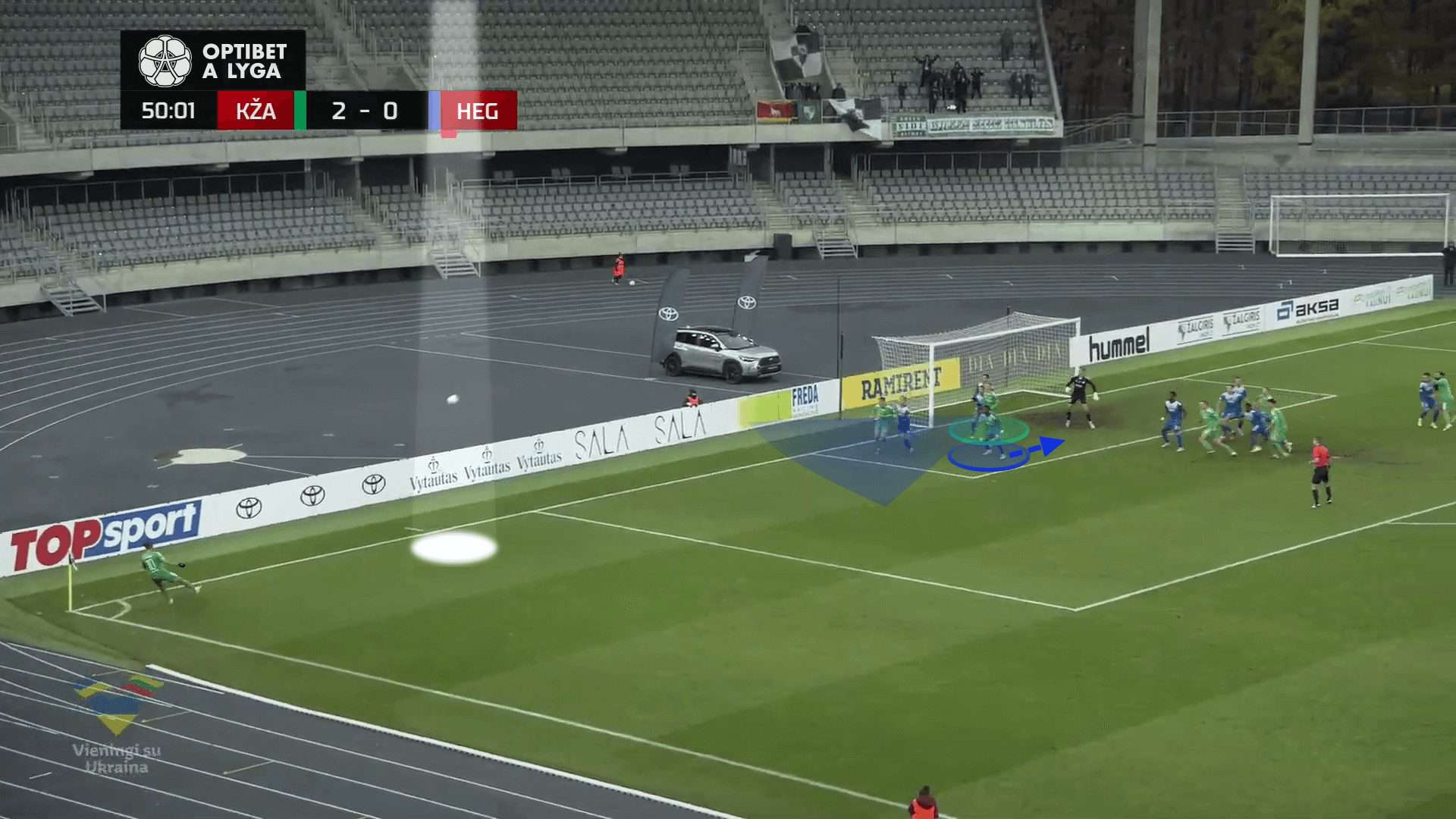
Another reason for the timing of this movement being vital is that even though the runs were usually decoys, there were occasions when the delivery would be a little flatter. Those decoy runners actually had the opportunity to header the ball as it arrived in the areas just in front of the near side of the six-yard box.
Arriving from behind the defender’s back means that they were out of sight while building their momentum, allowing the attackers to arrive in the zone highlighted with a yard of separation and header the ball unopposed.
This gives Kauno Žalgiris added possibilities of making the first contact, whether that is through a flatter cross being met by an oncoming decoy player or inside the six-yard box by a player arriving in the space the zonal defender vacates, following those decoys.
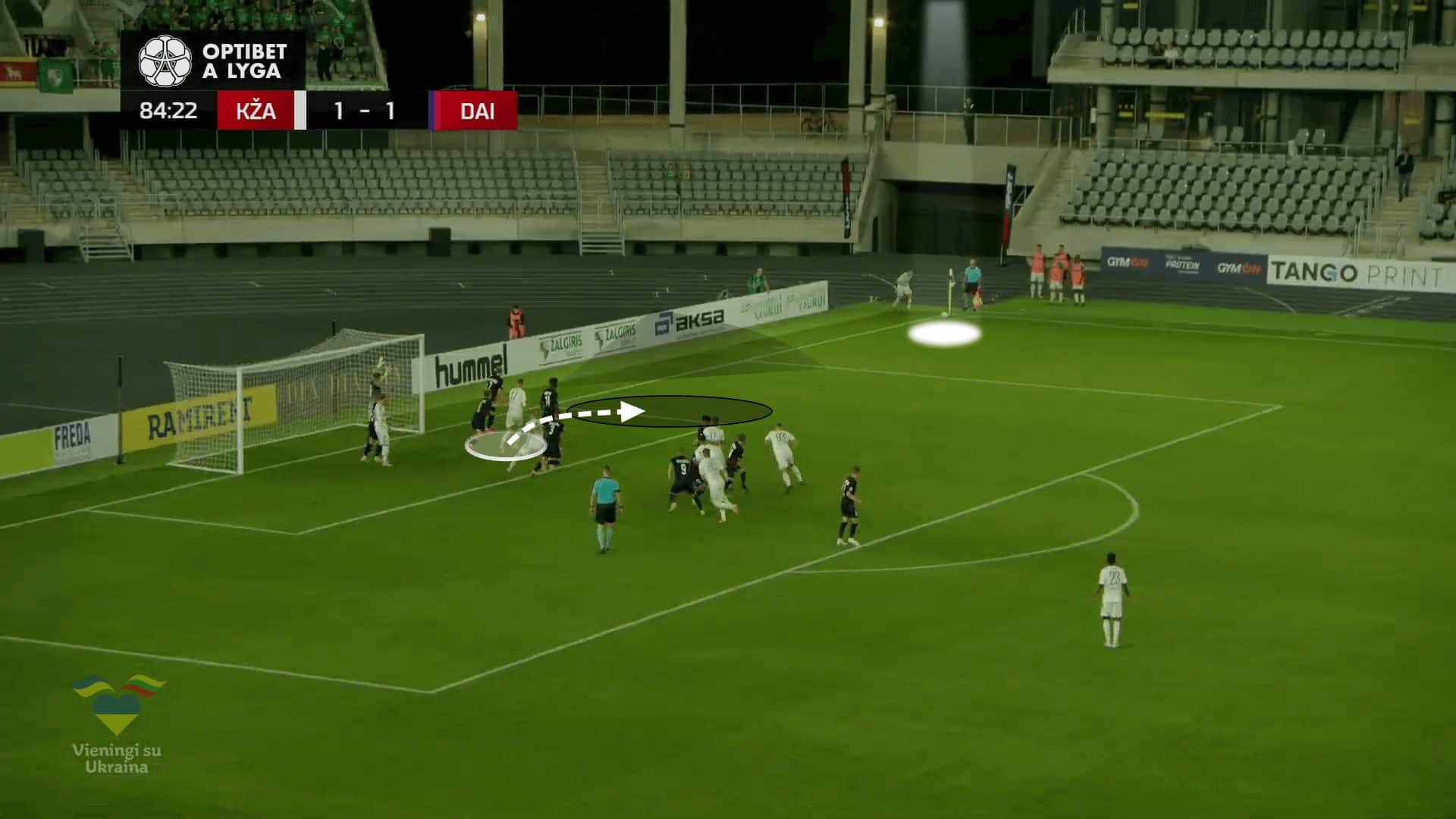
As with most successful, efficient corner routines, it’s crucial to have the fundamentals covered. For every corner taken, players must be ready to anticipate and react to loose balls, rebounds and flick-ons.
When a corner is taken, one player makes the movement towards the back post to clean up any mess in a sense. Any ball that is either headed wide or blocked or saved from the initial effort will likely move across the back post, where one player is ready to finish the action or keep the ball alive at the very least by putting it back across the goal.
As seen in the example below, because of the train setup, the player at the back of the queue has that separation needed to arrive at the back post unmarked, as his marker’s path towards the back post is blocked by all the teammates ahead of him in the queue.
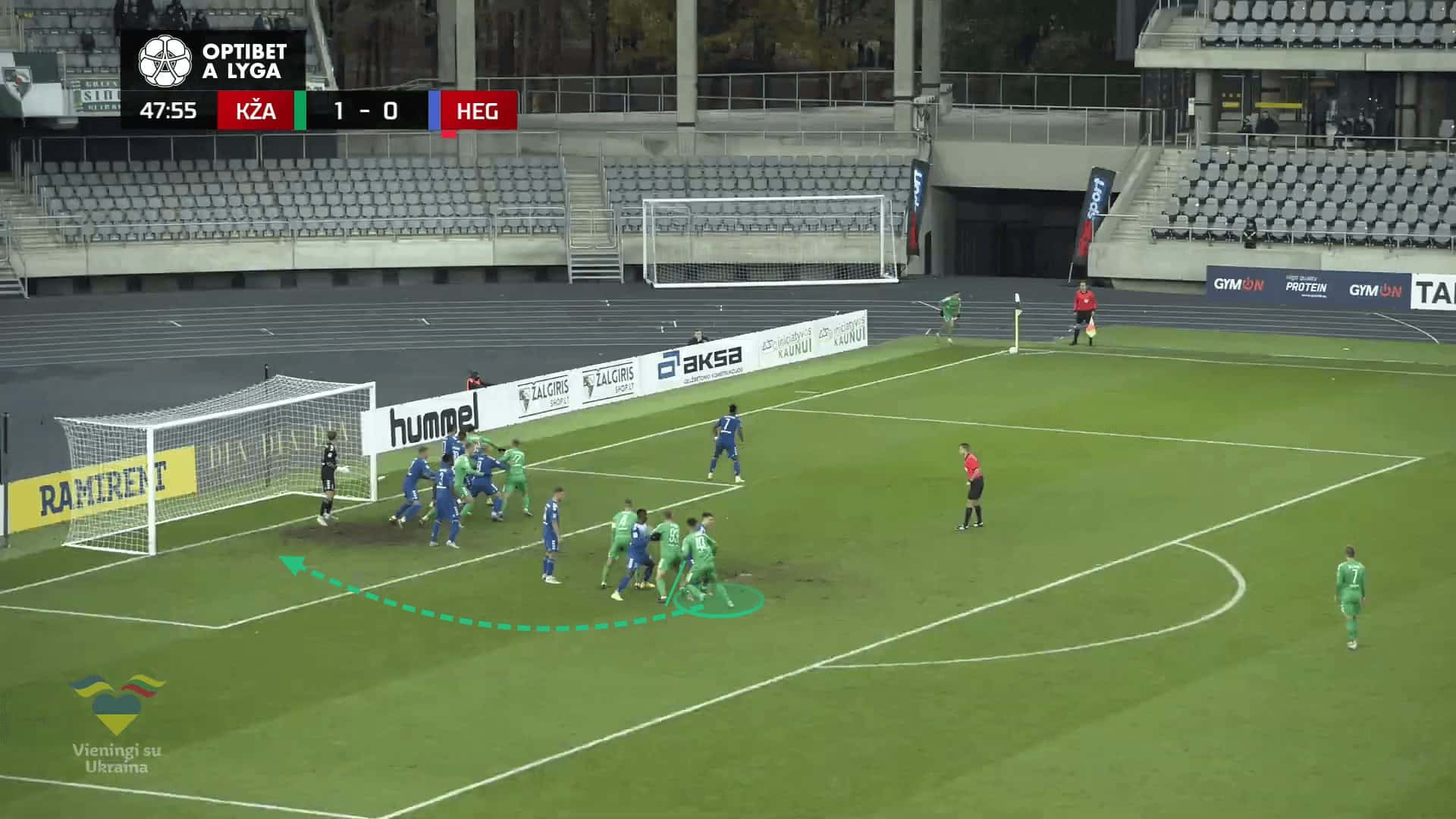
Another method used to ensure the corner kicks are as dangerous as possible is through sustaining pressure following corner kicks. As discussed in this article, there will always be a player making a decoy run, meaning that the nearest player to the ball, should it be under-hit, will always be a Kauno Žalgiris player.
This instantly prevents the opposition team from being able to volley the ball clear of danger, which allows the attacking side to put as many bodies as possible into the final third, as the ball is extremely unlikely to be cleared further than 30 yards from the initial header.
Kauno Žalgiris use this advantage to put more bodies around the edge of the box to increase the probability of winning the loose balls in the second phase should a cross be headed away from the six-yard box.
A slight negative to note is the inconsistency in the use of this, where there have been occasions where fewer bodies were used around the penalty area. The image below shows three players controlling the entire width of the box, but at times, there are fewer players, meaning that they are more vulnerable to the opposition side reacting to the loose ball first if it bounces to an uncovered part of the box.
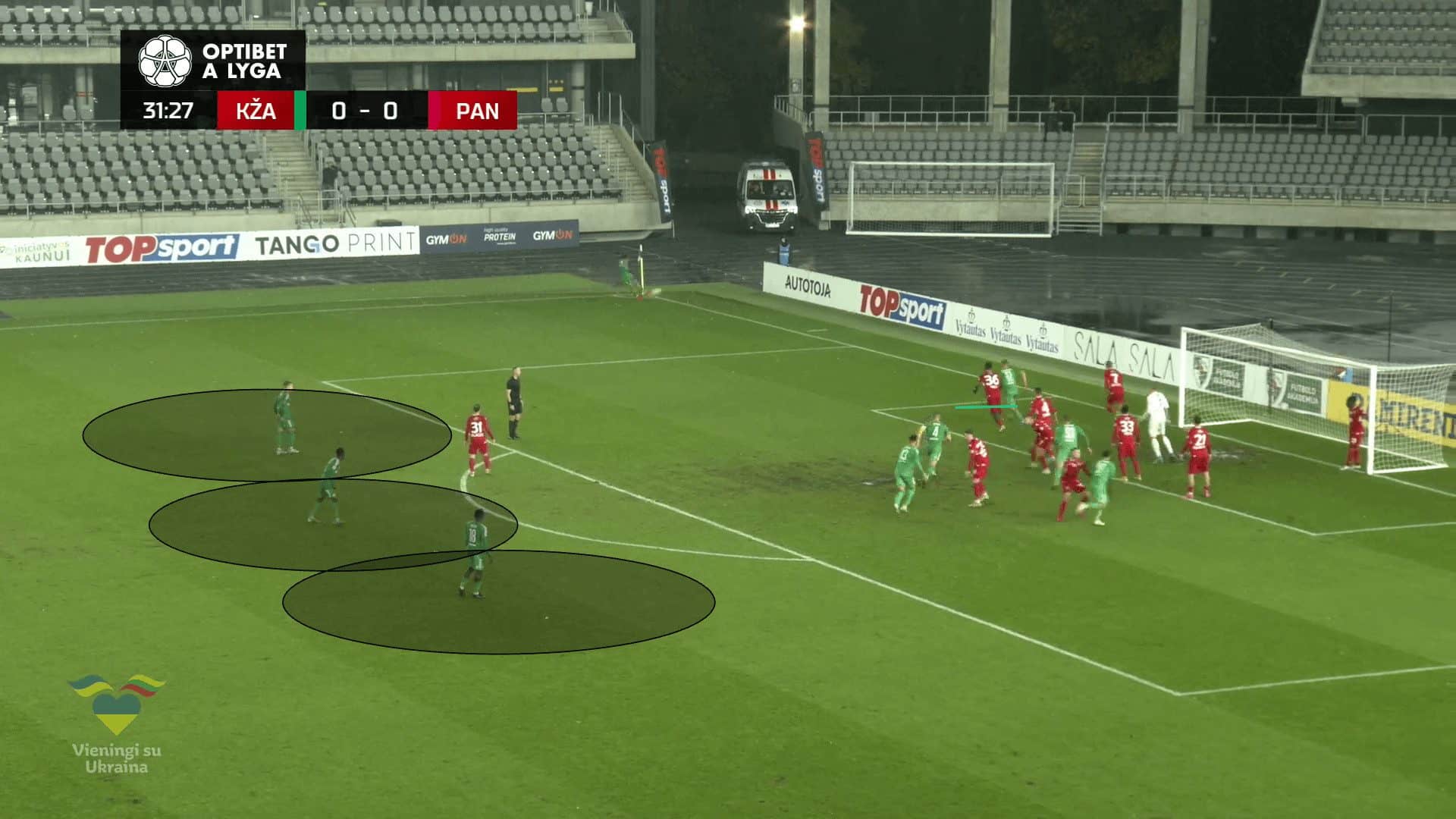
In addition, there is no block on the goalkeeper, meaning that balls which arrive inside the six-yard box are vulnerable to being claimed by the opposition goalkeeper. However, due to the preference for flatter deliveries into the near half of the six-yard box, there are generally fewer opportunities for the goalkeeper to claim the ball.
One slight variation to this routine, which Kauno Žalgiris have used this season, has been to the direction of the decoy runners. In the example below, we can see the two attackers start in the same place as usual, but rather than attacking the space on the near edge of the six-yard box, they make movements away from the goal, towards the edge of the penalty area.
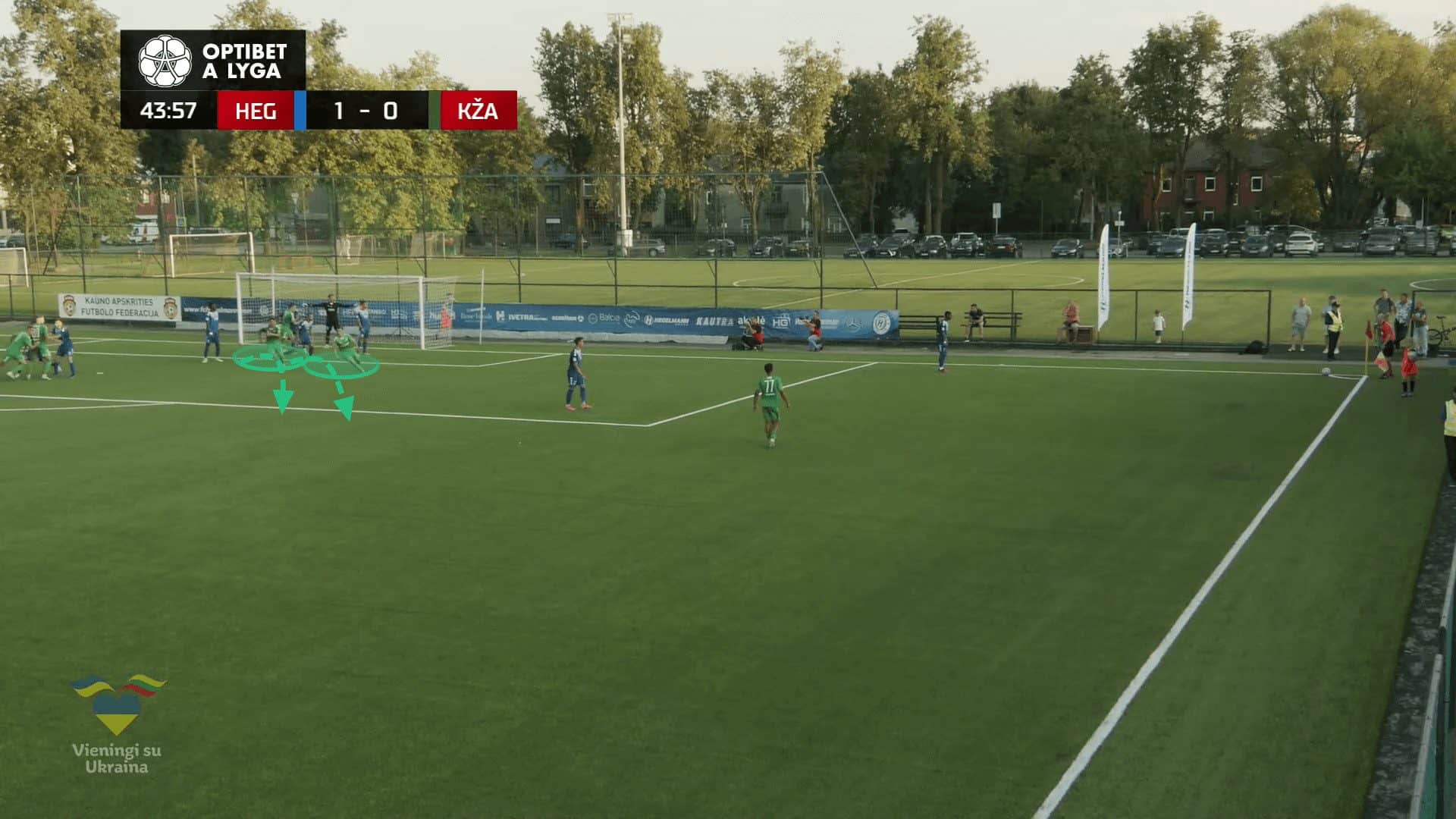
The issue with players moving away from the goal is that it doesn’t cause the zonal defenders to panic as the threat level is reduced. This means that the decoy is almost ineffective, as the defenders have no reason to vacate their spaces to follow someone out of the box, so this doesn’t lead to space being created inside the six-yard box.
This variation has potential to be effective, but due to the rarity of the routine, it seems as if it was an idea that was given up on. With the attackers not being followed as they move away from the box, this gives Kauno Žalgiris the ability to change the roles of those two players into fake decoys, where they initially act uninterested, which allows them to be unmarked, before making a second movement towards the ball.
While they move away from the six-yard box, the two decoy runners are able to find themselves in space around the penalty spot, from where they can make unopposed sprints into the six-yard box, where the sprinting momentum instantly gives them an advantage in aerial duels over zonal defenders.
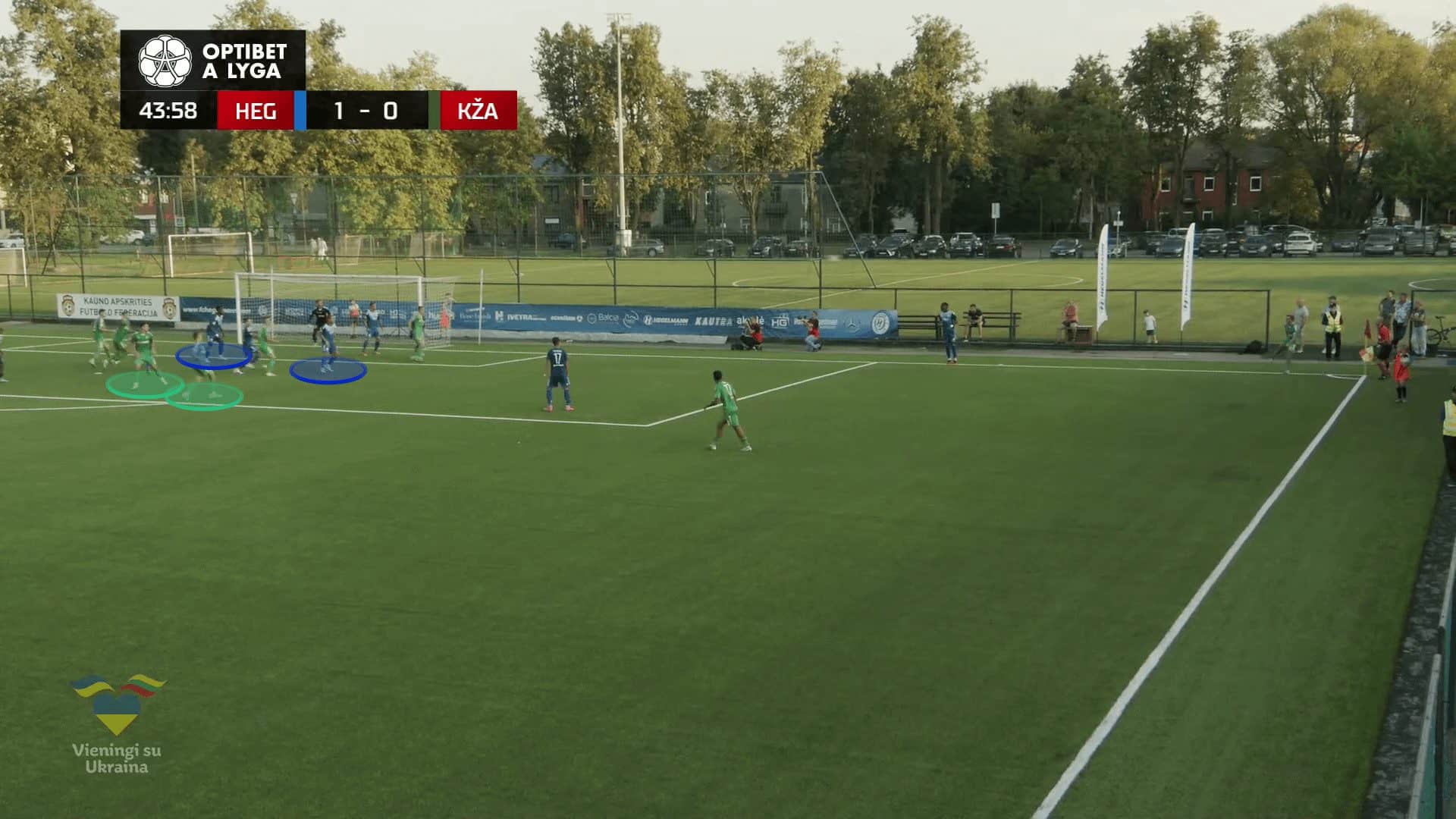
Conclusion
This set-piece analysis has thoroughly shown the intricate details used by Kauno Žalgiris to create a deadly corner routine. The attention in detail to each attacker’s role in the penalty area gives each player clarity in what is expected from them and makes each player’s job easier, with every teammate pulling in the same direction.
Using decoy runs, arriving from a defender’s blind side is an effective method for chance creation from corners, made evident by the likes of Arsenal and Tottenham in the Premier League in the past. The slight variations to the method used by Kauno Žalgiris are clearly equally effective and should be utilised more often among the elite level of football.






Comments